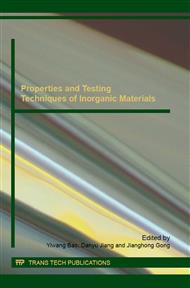p.208
p.212
p.216
p.220
p.224
p.228
p.233
p.238
p.244
Silica Encapsulation of SrAl2O4:Eu2+, Dy3+ Phosphors by Sol-Gel Method
Abstract:
SrAl2O4:Eu2+,Dy3+ phosphors were synthesized under different temperature by high temperature solid phase method. Encapsulation modification of SrAl2O4:Eu2+,Dy3+ by using SiO2 glycol were made over chemically unstable against water. Photoluminescence measurement result shows that when the sintering temperature is 1300 °C, the initial afterglow brightness of SrAl2O4:Eu2+,Dy3+ is up to the highest, 12101 mcd/m2. FTIR results showed that new IR peaks at 1085 cm−1 due to the vibration of Si-O-Si and at 931cm−1 due to the vibration of Si-O-Al appeared after silica encapsulation. This verified that the silica encapsulation is not only a physical absorption process but also involving chemical bonding process. Both phosphors before and after encapsulation have same emission peak at 510 nm. A dense layer of silica formed on phosphor surface has the highest water-resistance after being encapsulated for 2h under the condition of pH 4 and encapsulation amount 10:1. The pH value of aqueous solution contained phosphor was steadily 8, and the initial afterglow brightness decreased only by 9%, that is, from 12101 to 11011 mcd/m2.
Info:
Periodical:
Pages:
224-227
Citation:
Online since:
February 2016
Authors:
Keywords:
Price:
Сopyright:
© 2016 Trans Tech Publications Ltd. All Rights Reserved
Share:
Citation:


